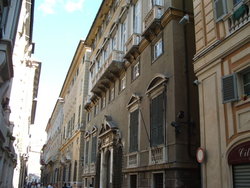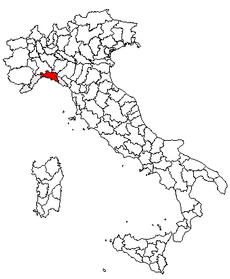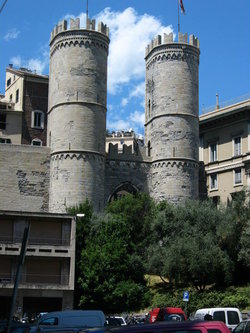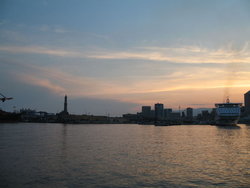Genoa
| Genoa | |
|---|---|
| City: | Comune di Genova |
| Region: | Liguria |
| Province: | Genoa (GE) |
| Altitude: | 20 |
| Area cityproper: | 243 |
| Population as of: | 2006 |
| Population density: | 620,316 |
| Population density metric: | 2,553 |
| Timezone: | CET, UTC+1 |
| Frazioni: | Acquasanta, Vesima |
| Telephone: | 010 |
| Postal code: | 16100 |
| Gentilic: | Genovesi |
| Saint: | St. John the Baptist |
| Day: | June 24 |
| Mayor: | Giuseppe Pericu (since 2005-05-30) |
| Website: | www.comune.genova.it |
Genoa (Genova ['dʒɛːnova] in Italian, Zena ['zeːna] in Genoese, Genua in Latin and, archaically, in English) is a city and a seaport in northern Italy, the capital of the Province of Genoa and of the region of Liguria. The city has a population of ca. 620,000 and the urban area has a population of ca. 890,000. Genua was a city of the ancient Ligurians. Its name is probably Ligurian, meaning "knee" (from Ancient Greek gony "knee"), i.e. "angle", from its geographical position, thus akin to the name of Geneva. Or it could derive from the Celtic root genu-, genawa (pl. genowe), meaning "mouth", i.e., estuary. Part of the old city of Genoa was inscribed on the World Heritage List (UNESCO) in 2006 (see below).
Flag
The flag of Genoa is the St. George's flag, a red cross on a lime white field, almost identical to the Flag of England. It is probable that the flag of Genoa was adopted by England and the City of London in 1190 so their ships entering the Mediterranean would benefit from the protection of the powerful Genoese fleet. However, historians agree that the actual origins of the flag are unclear (Encyclopaedia Britannica).
History
Ancient era and early Middle Ages
Genoa's history goes back to ancient times. The first historically known inhabitants of the area are the Ligures, an Italic tribe. The attribution of its foundation to Celts in 2500–2000 BC has been recently recognized as wrong.
A city cemetery, dating from the 6th and 5th centuries BC, testifies to the occupation of the site by the Greeks, but the fine harbor probably was in use much earlier, perhaps by the Etruscans. It is also probable that the Phoenicians had bases in Genoa, or in the nearby area, since an inscription with an alphabet similar to that used in Tyre has been found.
In the Roman era, Genoa was overshadowed by the powerful Marseille and Vada Sabatia, near modern Savona. Different from other Ligures and Celt settlements of the area, it was allied to Rome through a foedus aequum ("Equal pact") in the course of the Second Punic War. It was therefore destroyed by the Carthaginians in 209 BC. The town was rebuilt and, after the end of the Carthaginian Wars, received municipal rights. The original castrum thenceforth expanded towards the current areas of Santa Maria di Castello and the San Lorenzo promontory. Genoese trades included skins, wood, and honey. Goods were shipped in the mainland up to important cities like Tortona and Piacenza.
After the fall of the Western Roman Empire, Genoa was occupied by the Ostrogoths. After the Gothic War, the Byzantines made it the seat of their vicar. The Lombards submitted it in 643. In 773 the Lombard Kingdom was annexed by the Frank empire; the first Carolingian count of Genoa was Ademarus, who was given the title praefectus civitatis Genuensis. Ademarus died in Corsica while fighting against the Saracens. In this period the Roman walls, destroyed by the Lombards, were rebuilt and extended.
For the following several centuries, Genoa was little more than a small, obscure fishing center, slowly building its merchant fleet which was to become the leading commercial carrier of the Mediterranean Sea. The town was sacked and burned in 934 by Arab pirates but it was quickly rebuilt.
In the 10th century the city, now part of the Marca Januensis ("Genoese Mark") was under the Obertenghi family, whose first member was Obertus I. Genoa was one of the first cities in Italy to have some citizenship rights granted by local feudataries.
Middle Ages and Renaissance
Main article: Republic of Genoa
Before 1100, Genoa emerged as an independent city-state, one of a number of Italian city-states during this period. Nominally, the Holy Roman Emperor was overlord and the Bishop of Genoa was president of the city; however, actual power was wielded by a number of "consuls" annually elected by popular assembly. Genoa was one of the so-called "Maritime Republics" (Repubbliche Marinare), along with Venice, Pisa, and Amalfi) and trade, shipbuilding and banking helped support one of the largest and most powerful navies in the Mediterranean. The Adorno, Campofregoso, and other smaller merchant families all fought for power in this Republic, as the power of the consuls allowed each family faction to gain wealth and power in the city. The Republic of Genoa extended over modern Liguria and Piedmont, Sardinia, Corsica and had practically complete control of the Tyrrhenian Sea. Through Genoese participation on the Crusades, colonies were established in the Middle East, in the Aegean, in Sicily and Northern Africa. Genoese Crusaders brought home a green glass goblet from the Levant, which Genoese long regarded as the Holy Grail.
The collapse of the Crusader States was offset by Genoa’s alliance with the Byzantine Empire, which opened opportunities of expansion into the Black Sea and Crimea. Internal feuds between the powerful families, the Grimaldi and Fieschi, the Doria, Spinola, and others caused much disruption, but in general the republic was run much as a business affair. Genoa's political zenith came with its victory over the Duchy of Pisa at the naval Battle of Meloria (1284), and its persistent rival, Venice, in 1298.
However, this prosperity did not last. The Black Death was imported into Europe in 1349 from the Genoese trading post at Caffa (Theodosia) in Crimea, on the Black Sea. Following the economic and population collapse, Genoa adopted the Venetian model of government, and was presided over by a doge (see Doge of Genoa). The wars with Venice continued, and the War of Chioggia (1378–1381), ended with a victory for Venice. After a period of French domination from 1394–1409, Genoa came under rule by the Visconti of Milan. Genoa lost Sardinia to Aragon, Corsica to internal revolt and its Middle Eastern colonies to the Ottoman Empire and the Arabs.
Christopher Columbus, a native of Genoa, donated one-tenth of his income from the discovery of the Americas for Spain to the Bank of San Giorgio in Genoa for the relief of taxation on foods. The Spanish connection was reinforced by Andrea Doria, who established a new constitution in 1528, making Genoa a satellite of the Spanish Empire. Under the ensuing economic recovery, many Genoese families amassed tremendous fortunes. At the time of Genoa’s peak in the 16th century, the city attracted many artists, including Rubens, Caravaggio and Van Dyck. The famed architect Galeazzo Alessi (1512–1572) designed many of the city’s splendid palazzi. A number of Genoese Baroque and Rococo artists settled elsewhere and a number of local artists became prominent.
Genoa suffered from French bombardment in 1684, and was occupied by Austria in 1746 during the War of the Austrian Succession. In 1768, Genoa was forced to also cede Corsica to France.
Modern history
With the shift in world economy and trade routes to the New World and away from the Mediterranean, Genoa's political and economic power went into steady decline.
In 1797, under pressure from Napoleon, Genoa became a French protectorate called the Ligurian Republic, which was annexed by France in 1805. This affair is commemorated in the famous first sentence of Tolstoy's War and Peace:
"Well, Prince, so Genoa and Lucca are now just family estates of the Buonapartes.(...) And what do you think of this latest comedy, the coronation at Milan, the comedy of the people of Genoa and Lucca laying their petitions [to be annexed to France] before Monsieur Buonaparte, and Monsieur Buonaparte sitting on a throne and granting the petitions of the nations?" (spoken by a throughly anti-Boanapartist Russian aristocrat, soon after the news reached St. Petersburg).
Although the Genoese revolted against France in 1814 and liberated the city on their own, delegates at the Congress of Vienna sanctioned its incorporation into Piedmont (Kingdom of Sardinia), thus ending the three century old struggle by the House of Savoy to acquire the city. The king of Piedmont even sent the Bersaglieri to sack the city, defining the Genoese as "scum". The city soon gained a reputation as a hotbed of anti-Savoy republican agitation, although the union with Savoy was economically very beneficial. With the growth of the Risorgimento movement, the Genoese turned their struggles from Giuseppe Mazzini's vision of a local republic into a struggle for a unified Italy under a liberalized Savoy monarchy. In 1860, Giuseppe Garibaldi set out from Genoa with over a thousand volunteers to begin the campaign. This is called the departure of the thousands and a monument is set on the rock where the group departed from.
During World War II the British fleet bombarded Genoa and one bomb fell into the cathedral of San Lorenzo without exploding. It is now available to public viewing on the cathedral premises.
The 27th G8 summit in the city, in July 2001, was overshadowed by violent protests, with one protester, Carlo Giuliani, killed amid accusations of police brutality. Trials of accused officials are ongoing as of 2007.
In 2004, the European Union designated Genoa as the European Capital of Culture, along with the French city of Lille.
Main sights
- For a more extensive list, see Buildings and structures in Genoa.

| |
| Genoa: Le Strade Nuove and the system of the Palazzi dei Rolli | |
|---|---|
| State Party | |
| Type | Cultural |
| Criteria | ii, iv |
| ID | 1211 |
| Region | Europe and North America |
| Year | 2006 |
| Session | 30th |
| Link | http://whc.unesco.org/en/list/1211 |
The main features of central Genoa include Piazza de Ferrari, around which are sited the Opera and the Palace of the Doges. There is also a house where Christopher Columbus is said to have been born.
Strada Nuova (now Via Garibaldi), in the old city, was inscribed on the World Heritage List in 2006. This district was designed in the mid-16th century to accommodate Mannerist palaces of the city's most eminent families, including Palazzo Rosso (now a museum), Palazzo Bianco, Palazzo Grimaldi and Palazzo Reale. The famous art college, Musei di Strada Nuova and the Palazzo del Principe are also located on this street.
Other landmarks of the city include St. Lawrence Cathedral (Cattedrale di San Lorenzo), the Old Harbor (Porto Antico), transformed into a mall by architect Renzo Piano, and the famous cemetery of Staglieno, renowned for its monuments and statues. The Museo d'Arte Orientale has one of the largest collections of Oriental art in Europe.
Other than the old city sights, Genoa also has a large aquarium located in the above-mentioned old harbor. The Aquarium of Genoa is one of the largest in Europe.
The port of Genoa also contains an ancient lighthouse, called La Lanterna (i.e., "the lantern"). It is the oldest working lighthouse in the world, one of the five tallest ones, and the tallest brick one and it is Genoa's landmark.
One of the most beautiful and pictoresque Genoese neighbourhood is Boccadasse in the east of the city.
Demographics
The population is homogeneously Italian. Southern and northern Italians alike flocked to the city during the late 1900s. An estimated 95.3% of the population is of Italian origin. But there has been a sharp increase of immigrants mostly from South America, Eastern Europe, and a very meagre number from Asia. [1]
Immigrants by country (2004):
Sports
Football
Genoa Cricket & Football Club gives to the City of Genoa the very first football club founded in Italy. The club was founded in 1893 by James Spensley, an English doctor, and has won 9 championships and a Italy Cup.
Another football club in the city is U.C. Sampdoria, founded in 1946 from the merger of two existing clubs, Andrea Doria (founded in 1895) and Sampierdarenese (founded in 1911). Sampdoria has won one Italian championship, 4 Italy Cups and 1 UEFA Cup Winners' Cup in 1989/90.
Famous people
Famous Genoese include Sinibaldo and Ottobuono Fieschi (Popes Innocent IV and Adrian V) and Pope Benedict XV, navigators Christopher Columbus and Andrea Doria, composers Niccolò Paganini and Michele Novaro, Italian patriots Giuseppe Mazzini and Nino Bixio, writer and translator Fernanda Pivano, poet Edoardo Sanguineti, Communist politician Palmiro Togliatti, architect Renzo Piano, Physics 2002 Nobel Prize winner Riccardo Giacconi, Literature 1975 Nobel Prize winner Eugenio Montale, the artist Vanessa Beecroft, comedians Gilberto Govi, Paolo Villaggio, Beppe Grillo, Luca Bizzarri and Maurizio Crozza; singer-songwriters Fabrizio de André and Ivano Fossati, actor Vittorio Gassman, and actress Moana Pozzi, Giorgio Parodi who conceived the motorcycle company Moto Guzzi with Carlo Guzzi and Giovanni Ravelli. Some reports say Giovanni Caboto (John Cabot) is also from Genoa, others say he was from Savona.
Miscellaneous
- The University of Genoa, with 40,000 students (one of the largest universities in Italy) was founded in 1471.
- The word jeans comes from Genoa, as a way to pronounce genoese.
- The Genoese have emigrated too, mostly to South America; Uruguay, Chile, Argentina have strong Genoese communities. The special strong connection with Argentina is witnessed by the famous song Ma se ghe penso, and by the episode From the Apennines to the Andes in the book Cuore (Heart) by Edmondo De Amicis]; the supporters of the Boca Juniors football team, rooted in the neighborhood of La Boca, in Buenos Aires, are known as los xeneizes. Most inhabitants of those countries will recognize Farinata (Faina as they call it, a chickpea flatbread) and Torta Pasqualina (a salty artichokes, eggs, and cheese pie) as local dishes, but they are from Genoa. A significant portion of Gibraltar's population is of Genoese origin.
- The Yiddish word Yanova with which Ashkenazi Jews are most commonly calling the Diamante Citron, is a jargon from the city of Genoa which was the transport station for the citron or as they are calling it Etrog.
- Florida International University in Miami, Florida in the United States has a regional campus in Genoa.
Sister cities
- Baltimore, USA
- Boston, USA
- Chios, Greece
- Columbus, USA
- Guayaquil, Ecuador
- Huelva, Spain
- Marseille, France
- Odessa, Ukraine
- Rijeka, Croatia
See also
- Republic of Genoa
- Genoese dialect
- Ligurian language
- Metropolitana di Genova
- Wikipedia in Ligurian language
- Amoco Haven tanker disaster
Image gallery
Bibliography
- Gino Benvenuti. Le repubbliche marinare. Amalfi, Pisa, Genova e Venezia. Netwon Compton, Rome, 1989.
- Steven A. Epstein; Genoa & the Genoese, 958-1528 University of North Carolina Press, 1996; online edition
- Steven A. Epstein; "Labour and Port Life in Medieval Genoa." Mediterranean Historical Review 3 (1988): 114-40.
- Steven A. Epstein; "Business Cycles and the Sense of Time in Medieval Genoa." Business History Review 62 ( 1988): 238-60.
- Face Richard. "Secular History in Twelfth-Century Italy: Caffaro of Genoa." Journal of Medieval History 6 (1980): 169-84.
- Hughes Diane Owen. "Kinsmen and Neighbors in Medieval Genoa." In The Medieval City, edited by Harry A. Miskimin, David Herlihy, and Adam L. Udovitch, pp. 3-28. 1977.
- Hughes Diane Owen. "Urban Growth and Family Structure in Medieval Genoa." Past and Present 66 (1975): 3-28.
- Lopez Robert S. "Genoa." In Dictionary of the Middle Ages, pp. 383-87. 1982.
- Vitale Vito. Breviario della storia di Genova. Vols. 1-2. Genoa, 1955.
External links
- Official Site
- The official lighthouse website
- Genoa on google maps
- Palazzi dei Rolli of Genoa
- The Italian Institute of Technology
- Genoa Cricket and Football Club
- Unione Calcio Sampdoria
| L'Aquila (Abruzzo) · Aosta (Aosta Valley) · Bari(Apulia) · Potenza (Basilicata) · Catanzaro (Calabria) · Naples (Campania) · Bologna (Emilia-Romagna) Trieste (Friuli-Venezia Giulia) · Rome (Lazio) · Genoa (Liguria) · Milan (Lombardy) · Ancona (Marche) · Campobasso (Molise) · Turin (Piedmont) |
| Regions of Italy | ||||
|---|---|---|---|---|
| Abruzzo • Aosta Valley • Apulia • Basilicata • Calabria • Campania • Emilia-Romagna • Friuli-Venezia Giulia • Lazio • Liguria • Lombardy • Marche • Molise • Piedmont • Sardinia • Sicily • Trentino-South Tyrol • Tuscany • Umbria • Veneto | ||||













